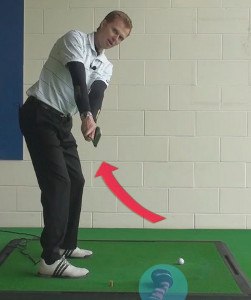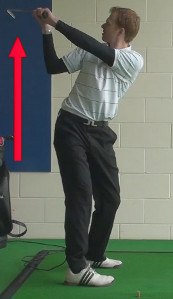
Getting the club “across the line” at the top of the backswing is a recipe for pushed and hooked shots, but the “laid-off” position can cause something much worse: the shanks.
A shank – when the ball contacts the hosel of an iron and rockets wildly to the right (for a right-hander) – is the most damaging mistake in golf. The most common cause is a laid-off backswing position, where the club points away from the golfer, left of the target line (for a right-hander) at the top. From here, the clubhead approaches the ball from well inside the line on the downswing; unless the golfer can rotate the hands quickly and with proper timing, a shank often ensues.
The laid-off position is often rooted in a faulty takeaway. The most common error is taking the club back too far to the inside and on a plane that's too flat, or horizontal. Here's how to fix your laid-off backswing – and stop the shanks dead in their tracks.
- On the driving range, place a headcover or similar object 6-10 inches behind your ball and just inside the target line.

- Take the club straight back from the ball without touching the object, and complete your swing making sure to miss the object coming down as well.
This drill will put your swing on a more upright or vertical plane so that the club is parallel to the target line, or pointing slightly across the line, as you reach the top.

Laid Off at the Top? Here's Help
Putting the golf club in good positions throughout the swing is the best way to make solid contact time after time. If you wish to be able to control your ball flight and produce shots that match the shape of the hole in front of you, managing the position of the club is the first step. Everything you do throughout the swing leads you ultimately to your impact position, so even the smallest details can have an effect on the shots that you hit. Take the time to fine tune your swing positions and your game as a whole will benefit.
One of the biggest swing problems that amateur golfers face is having the club laid off at the top of the backswing. What does that mean? For a right handed golfer, the club is laid off at the top of the swing when it is pointing to the left of the target. In an on-plane swing, the club will point (roughly) at the target when you reach the top of your backswing. If you are laid off, the club will be pointing out to the left and the club head will be farther away from your body. While it is possible to hit good shots from this position, most players are going to benefit from getting the club on-plane to make for an easier, more-repeatable downswing motion.
It can be difficult to address this problem simply because you can't see the club at this point in your swing. With the club wrapped around your back, there is no way to see if the shaft of the club on-plane on laid off. In order to properly diagnose this problem in your swing, it may be helpful to use a mirror or a video recorder. By placing a mirror behind you while you swing, you will be able to view the position of the club at the top of the backswing. Likewise, watching your swing back on video is another great way to analyze your positions. Unless you have a golf teacher who can watch your swing and make corrections, using a mirror and/or video is the best way to go.
Remember that you shouldn't go making changes to your golf swing unless they are necessary. For example, if you are making a swing that is laid off at the top but you are still hitting great shots, don't make any radical changes. You should only change your swing if you have a specific goal in mind. Unless you feel that you are being held back by your swing mechanics, stick with what have been doing up to this point. However, if your laid off position is hurting your game and preventing you from lowering your scores, then it is time to get to work on correcting the problem.
All of the content below is based on a right handed golfer. If you happen to play left handed, please reverse the directions accordingly.

Symptoms of a Laid Off Backswing Position
The first sign that your swing is off track is when you begin to notice problems with your ball flight. If the ball starts to head in unexpected directions, you should quickly check your swing mechanics to find the root cause of the problem. The longer you wait to fix your swing, the more difficult those changes will be when you do get around to them. Don't let bad habits make their way into your swing – correct any issues as soon as possible to avoid long-term damage to your game.
In the case of a laid off position at the top of your backswing, there are a few things to watch for in your ball flight. If you notice one or more of the three problems below start to creep into your game, it will be time for a review of your mechanics.
- Slice. The slice is well-known as one of the most-common amateur problems, and a laid off position in your backswing can directly lead to this left-to-right ball flight. Since the club never quite gets on plane when you are laid off, the natural tendency is to come 'over the top' in your transition. As you lift the club up and away from your body to start the downswing, you will be putting the club in a position that requires you to swing across the ball from outside-in just to make contact. Many golfers spend years and years looking for the root cause of their slice, but it may be as simple as getting the top of your backswing into a better position.
- Pull. This one is directly related to the slice. When you are swinging down into the ball from outside-in, there are really only two outcomes that you can expect – a slice, or a pull. If your hands manage to get the club face square to your swing path, the pull is the ball flight that will result. While it is not usually as damaging as a slice, a pull is still not something that you want to deal with in your game. Putting the club in a better position at the top of the swing should allow you to deliver the club head on a better path into the ball, which will quickly eliminate your tendency to pull the ball to the left of the target.
- Shank. In the worst-case scenario, a laid off position at the top can lead to a shank. Again, it comes down to that outside-in path. When you swipe across the ball from outside-in, the hosel will be passing dangerously close to the golf ball. Unless your timing is perfect at the bottom of the swing, you will be running the risk of striking the ball with the hosel – which means a shank. You don't want to have to play golf with the fear of a shank in the back of your mind, so this is yet another reason to work on sorting out your backswing issues.
Each of these three problems can cause major issues on your scorecard, so it will be in your best interest to quickly get to work on fixing your swing mechanics. Watch for any changes to your ball flight that may indicate a problem with being laid off at the top of the swing. For example, if you suddenly start to pull a high percentage of your shots – when you usually don't pull the ball at all – you should be tipped off that something has changed in your technique. At this point, it is a good idea to use a mirror or video as mentioned above in order to get a good look at your top of the backswing position. If you are indeed laid off, move on to the next section to begin correcting the problem.
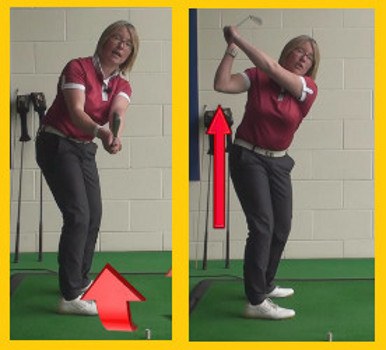
Causes of Laid Off Backswing Position
Once you determine that you are in fact laid off at the top, the next step is to determine why that is the case. You can't stop doing something unless you know what you are doing it in the first place. Fortunately, there are a number of common causes for reaching a laid off position, so your error is probably among the following list. Read through the points below while thinking about your swing to identify the culprit that is leading you astray.
- Lazy hands. There is a fine balance in the amount of hand action that you want to use during the backswing. If your hands are too active, they can cause the club to become across the line at the top. However, when they are too quiet, you may end up leaving the club laid off. Ideally, you want to use your hands only as much as is required to move the club into a perfectly on-plane position. For players who are not using their hands enough in the backswing, the best solution is usually to turn the grip slightly stronger. Take both hands and turn them to the right on the grip and you will make it easier for your hands to influence the movement of the club. Try making this slight adjustment to your set up and then make another backswing to see if the club is closer to an on-plane position.
- Under-rotating. To get the club all the way into position in the backswing, you need to make a full shoulder turn away from the target. That goal isn't always accomplished by amateur golfers, as many stop short of a full turn as they are in a hurry to start the forward swing. If you cut your backswing short and rush into the downswing, you will usually leave the club laid off and create problems as you come down into the ball. Work on improving your rhythm to allow the backswing to finish naturally before you move on. You don't have to make the biggest shoulder turn in the world as long as you leave plenty of time for the club to make it all the way into an on-plane position.
- Standing up out of your posture. Good posture is crucial to playing good golf, and losing your posture can damage your position at the top of the swing. If you stand up out of your stance (straighten your back and knees) during the backswing, the club is more likely to wind up laid off at the top. In order to allow the club the opportunity to make it into position, you want to pay close attention to holding the stance that you created at address. Maintain the flex in your knees and the angle in your back in order to let the club swing freely around your body.
If you have the club laid off at the top of the swing, it is a good bet that the reason can be found in the list above. By avoiding these three mistakes you can almost completely eliminate any chance of the club getting into a bad position at the top of the backswing. As a quick mental checklist, just keep these three points in mind – use your hands, complete your turn, and maintain your stance. If you can successfully do those three things in every swing that you make, leaving the club in a laid off position will be a problem of the past.
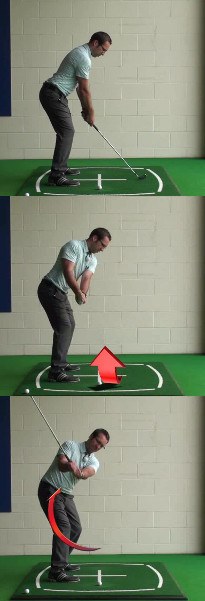
Use This Drill to Get On-Plane
The advice above should get you moving in the right direction with your swing, but you could probably benefit from the use of a drill to help you feel the correct positions. Drills are a great way to learn new concepts on the driving range, as they help bridge the gap between what you are reading and what you are actually doing. Spend some time with the following drill on the driving range and you should quickly be putting the club in a much better position.
- To start, head to the driving range with your seven iron and a bucket of golf balls. You can obviously bring your whole bag of clubs if you would like, but the seven iron is the only one you will be using for this drill.
- Before making your first swing, pick out a target that you can use to orient your stance. Prior to each swing, make sure to go through your pre-shot routine and carefully aim at your target just as you would for any shot on the course.
- After taking your stance properly, begin your backswing while trying to keep the club on a proper plane. When the club reaches parallel to the ground in the takeaway, stop and hold your position. At this point, check the angle of the shaft of the club compared to your feet. Ideally, the club shaft will be running parallel to the line created by the toes of your shoes. If the club is pointing out in front of you instead of running parallel to your feet, you are already laid off. Start the swing again and work on using your hands a little bit more to move the club into position. Don't move past this step until you can consistently place the club in the right spot when the shaft reaches parallel to the ground.
- After you have successfully passed step three, move on to the rest of your backswing. This time, you are going to pause just before the club starts to transition down. Hold your position at the top and drop your left hand off of the club. It is important that you hold the club steady with your right hand while you drop off with your left.
- Take your left hand to the left side of your body and try to grab the shaft of the club with your hand while not moving any other part of your body. If you can reach the club shaft successfully, you will know that you aren't laid off. However, if you can't reach without twisting or changing your stance, the club is too far laid off (and farther away from your head, which is why you can't reach the club). Just like in step three, continue to make adjustments to your backswing until you can reach the shaft of the club behind your head with your left hand.
- After getting through the practice swings successfully, go ahead and hit a few shots while remembering what you have learned. If you feel like you are drifting back into back habits, stop and start the drill over. Pay close attention to the position of the club shaft during the swing so you can avoid returning to the dreaded laid off position at the top of the swing.
You can easily integrate this drill into your regular practice routine. Just make the modified practice swing a couple of times before you start hitting balls to check on your positions. As long as the club is parallel to your toe line at the end of the takeaway (when the shaft is parallel to the ground), you will know the early part of your swing isn't causing any problems. Then, if you can reach the club behind your head with your left hand, you can be confident that you aren't laid off excessively. These two are easy checks, and they will go a long way to helping you place the club properly throughout the swinging motion.
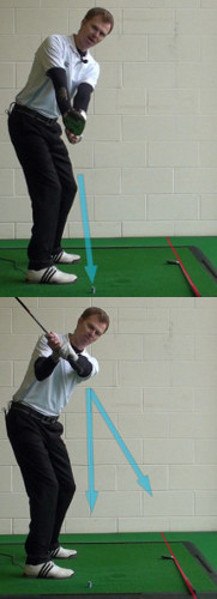
Other Adjustments
Once you have succeeded in getting the golf club in a good position, you will likely need to make a few adjustments to the rest of your game in order to achieve great results. Over the years, you have adapted to playing from a laid off position – which is exactly what you needed to do in order to get the most from your game. However, now that you aren't limited by playing from a laid off position, you can make a few adjustments to both the physical and mental side of what you do on the golf course. Take note of the following points before playing your first round with this new swing.
- Lead with your lower body. Most golfers who have the club laid off at the top also use an 'arms only' swing coming down into the ball. Now that you are on-plane, you will be able to aggressively move through the shot with your lower body. To engage your lower body successfully, it is important not to rush the transition phase of the swing. Allow yourself time to gather at the top, and then drive your hips rotation toward the target. When done in the correct order, a powerful downswing will be the result.
- Find your new ball flight. The standard ball flight that you achieve with your new and improved swing is sure to be different than the flight you saw from a laid off swing. Carefully watch how the ball is flying and take note of any new patterns that develop. You need to understand your ball flight in order to aim your shots correctly. It should only take a few rounds before you get comfortable with your new shot shapes, so get out on the course and start to 're-learn' your game.
- Longer distance. Expect to hit the ball farther now that the club is back on-plane. You will be coming into impact from a better angle, meaning that more of the energy from the club head is going to be transferred into the ball. Also, the added rotation from your lower body in the downswing should increase your overall club head speed. The end result is simple – the ball is going to fly farther, so adjust your club selections accordingly.
- Forget your fear of the slice. You have probably lived in fear of the slice (or the shank) on the golf course for as long as you can remember. Now that the club is on-plane, you can forget about those concerns and just focus your energy on hitting great shots. Confidence plays a big role in living up to your potential on the course, and having confidence in your swing means not fearing a big miss. Trust the work that you have done on the practice range and step up to each shot expecting great results.
If you have been playing golf for a long period of time from a laid off position, it is going to take some effort to break those habits and teach your body a new swing pattern. However, that effort will be worth it if you desire to take your game to a new level. Swinging the golf club on-plane is the best way to repeat your swing time after time. Inconsistency is likely to plague your game until you fix the laid off position that you are using currently. Take the advice above, including the drill, and work on straightening out the path of your golf club in the backswing. With the proper amount of effort and plenty of attention to detail, your golf swing can be corrected and your game will be in much better condition overall.


